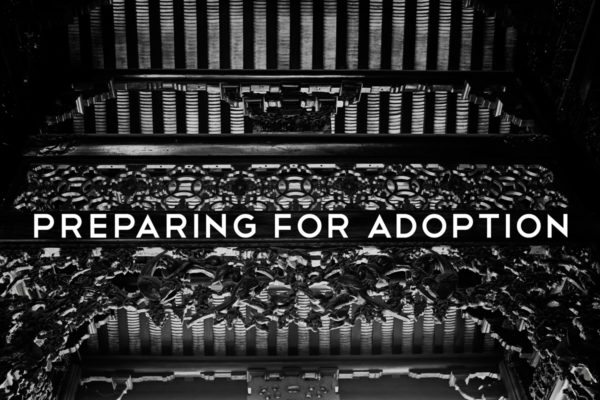You’ve dreamt for this day for months, years even. You’ve planned for it, are going to travel halfway around the world for it, and have played it out in your mind a million times. And yet, the reality of becoming a family through adoption is undoubtedly different.
As we have focused on Preparing for Adoption, we asked you to submit real questions for real answers from people whose business is preparing families for adoption for life.
We took those questions, narrowed them down to ten and asked a few of our friends to serve as a virtual panel to answer them in a two-part post. You can read part two here in which questions 5 through 10 are answered.

Question 1: We’re just starting our adoption paperwork. How do we navigate which special needs we’re open to as a couple? How can we get on the same page?
Answer from Heather Schuck, Family therapist at the UAB International Adoption Clinic at Children’s Hospital of Alabama:
The first step is understanding what specific special needs mean and the repercussions that might be present long term. There are some great resources to support families in this process. One of which is utilizing an adoption clinic that specializes in international adoption. Many of these clinics such as the UAB International Adoption Clinic of Children’s of Alabama offer a service called a special needs consult. With this service, a family can send their special needs checklist to the clinic and arrange a phone consult with one of our physicians specializing in international adoption. The physician will walk through this checklist with a family so that they can better understand which needs they feel most equipped to handle.
Gaining understanding on each special need allows parents to have a more informed conversation as a family, which is the second step. Discuss the implications (both positive and negative) to each need. Discuss how family dynamics might change if there are multiple doctors’ visits, surgeries, and therapies necessary. Finances, medical expenses, and an adequate insurance policy need to be discussed. Evaluating each of these areas in an open and honest way will bring a fuller picture to the realities of adopting a child with special needs.
The third step is to speak with families who are parenting children with the specific needs you are considering. Your adoption agency should be able to connect you with other families for support. Utilize this! Ask questions and continue to evaluate together.
Answer from Kelly Raudenbush, Attachment therapist at Attachment & Bonding Center of PA and Co-director of The Sparrow Fund:
It’s so exciting that you are here. I’m well aware that while you may be at the start of the paperwork, you’re well into this whole journey. Your start was likely months or even years ago, maybe starting with some seemingly casual conversation. That was the beginning. And, now you are here!
However your journey started, I bet you weren’t imagining staring down at a sheet of paper with a list of labels and having to check yes, no, or maybe beside each one.
There are professionals connected with international adoption clinics who you can access to help you understand what each of those labels generally mean. They can walk you through what life for your particular family could look like with the addition of a child with that label. These consultations can be invaluable for a couple reasons: (1) to provide simple education about labels that your general pediatrician may not commonly see and (2) to invite conversation between you and your spouse, conversation that may be difficult to have without someone asking you hard questions.
Whether or not you go the route of utilizing a professional to help you, I want to emphasize the importance of being honest with yourself about your strengths and limitations and what you can or cannot handle and allowing your spouse to do the same. It’s okay to check no. It really is.
Build a relationship with your case manager at your adoption agency as you work through all this. Let him or her get to know you and your hearts. Children are complex and often don’t fit into a neat little box. As you connect with your agency about where you both are, they will better know when to make that phone call to tell you they have a child they’d like you to consider and how to support you when they do.

Question 2: Can you share some tips for keeping our marriage healthy as we walk through the adoption process? There’s more tension than usual around our house!
Answer from Heather Schuck, Family therapist at the UAB International Adoption Clinic at Children’s Hospital of Alabama:
The adoption process is full of ups and downs that can feel like an emotional rollercoaster! Unfortunately, often times, we take our stress out on those we love most. Staying connected and engaged with your spouse during the ups and downs is possible.
Remember that your spouse is not the enemy. You are in this together. You need to make decisions together as a team. You can work through disagreements, and compromise might be needed, and that’s ok.
Make opportunities for connection. You may be saving every penny for your adoption fund, making date nights outside the home impossible. Get creative! Have “at home dates” where you check out a game or book from the library, decorate the “new room” for the child you are adopting, or cook dinner together. Even sitting down to have a simple conversation with intentional face-to-face time can be very connecting.
Make time for self-care. It may sound counterintuitive to say “do something for yourself” so that you can connect to your spouse. On an airplane, one of the first things you are told when it comes to safety regulations is “put the oxygen mask on yourself before putting it on someone else.” This is true in life. In order to connect to others in an intentional and real way, we must first connect to ourselves.
Think of the things that bring you life (going for a run, getting coffee with a friend, etc.). Make time to do those things even if it is once a week. These relieve stress and provide “oxygen” so that you can now connect to others more effectively.
Answer from Kelly Raudenbush, Attachment therapist at Attachment & Bonding Center of PA and Codirector of The Sparrow Fund:
You aren’t alone in feeling that tension. It makes a lot of sense that you would. You’re facing so many unknowns. Heather offered some great practical tips. Expanding a bit on what she shared — don’t hesitate to tell your spouse what you need. He or she knows you really well but cannot read your mind. Be both bold and gentle as you share what you are feeling and perhaps one way he or she can encourage you or love you in it. Invite your spouse to do the same to you.
Our responses will be imperfect, but simply the intention to serve and bless each other often diffuses some of that tension and reminds us that we are loved and in this together.
Answer from Angela Mains, Senior Family Therapist at Lifeline:
Marriage is a big topic! Marriage is the foundation of a family. When a marriage isn’t going well, it is not a surprise when children in the family see increased struggles. Furthermore, children born into families with marital dissatisfaction tend to struggle less than children adopted into homes with marital dissatisfaction. Marriage is hard, and while there might be cracks before adoption, it is not uncommon for adoption to widen those cracks into caverns if couples are not proactive in preventing this occurrence.
Marriage takes work. Adding a child will not change this; it will just make the need more pronounced. As Heather and Kelly said, be intentional in working on your marriage! Self-care and marriage-care should be a way of life, not something that happens on occasion.
If taking good care of yourself and your marriage seem to be a perpetual struggle, be honest in asking yourself why. Doing this work before you adopt and then maintaining the habit will be much easier than doing it after and trying to start new habits while assimilating a new family member.

Question 3: How do I best prepare our biological child for our adoption?
Answer from Heather Schuck, Family therapist at the UAB International Adoption Clinic at Children’s Hospital of Alabama:
In preparing your biological children for adoption, it is important to first evaluate their age and developmental understanding. At an earlier stage of development, it is important to use shorter phrases and lots of visual cues including pictures and videos, if available, of the child you are adopting as an introduction. Short discussions multiple times throughout the adoption process are helpful in preparing a young child already in your home for a new brother or sister.
For children a bit older and with increased knowledge and developmental understanding, visual cues such as pictures and videos are great along with more in depth discussions of the process. It is important for a child already in the home to understand some of the negative behaviors that might be exhibited by a new child in the family. Your agency should provide good education on preparing their own expectations for a child newly home. Depending on the age of the biological children, it often can be helpful for them to participate in that education as well.
Topics to discuss in an age appropriate way regarding a child newly home to help with sibling expectations:
• Physical acting out (hitting, biting, etc…)
• Rejecting behaviors (child not wanting to play, resisting affection)
• Sleeping/eating issues
Two areas that I see the most affected in families when newly adopted children come home are:
• Division in parent’s attentiveness to the other children
• Children already in the home observing and feeling the differences in parent discipline techniques between themselves and the newly adopted child
Both of these areas may cause jealousy with biological children. Having an open discussion of why each of these areas will be different (for a time) will help set expectations of children already in the home and give parents an opportunity to reset your own expectations.
I highly encourage having “dates” with your other children once your new child is home even if it is simply 10 minutes before bedtime a few times a week to discuss their day. Having intentional face-to-face time goes a long way to help with a transition. Remember, you will not be in transition forever!
Answer from Angela Mains, Senior Family Therapist at Lifeline:
Heather gave some great suggestions. Sibling issues are one of the number one reasons that adoptive placements fail. Parents see that the children already in their homes are at risk or are being harmed in some way and decide that they need to rehome to protect their other children. This is a big topic that is difficult to tackle in a paragraph or two! Check out this link for a video discussing this topic further.
Here are few things to keep in mind:
1. Stay attuned to your children. Pay attention to their signals. If you see a change in behavior, this might be a sign that your child is struggling with something. Rather than only deal with what might be unacceptable behavior, use that as a moment to go deeper and connect, especially if this new behavior is out of character for your child.
2. Don’t be afraid of your child’s anger, sadness, or other “negative” emotions. Adoption is a transition for everyone! Think about how many emotions you are experiencing as you walk this journey. You are an adult with so much more life experience than your children and a much greater capacity for understanding yourself and everything that you are feeling. Your children aren’t there yet, and they need you to help them through it. Whatever they are feeling is okay! Hear them out. You don’t have to fix it, just listen. They will feel better knowing that you understand and accept them anyway.
3. Teach your child appropriate self-protection skills. This is just good parenting. Children should understand from an early age that their body is their own and need to know that it is okay to say “no” to inappropriate touch. Talk through with them private areas and what to do if someone attempts to do this. Help them understand the rules of the house and teach them appropriate language. Give them scenarios and have them tell you what they might do. Act it out with puppets or stuffed animals. This topic understandably makes parents so nervous. Keep in mind that typically what is most traumatic for a child who has gone through some sort of sexual abuse is not having a calm adult/parent there to help them understand and let them know that it is going to be okay. Parents, your ability to be calm and understanding goes a long way!
Be sure to read post two, in which we cover questions 5 through 10!


























Leave a Reply